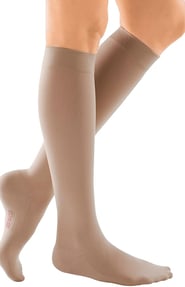Causes of Varicose Veins:
Weak or Damaged Valves: Veins have one-way valves that allow blood to flow towards the heart. When these valves weaken or become damaged, blood can flow backward and pool in the veins, leading to their enlargement and the formation of varicose veins.
Hormonal Changes: Hormonal fluctuations during pregnancy and menopause can contribute to the development of varicose veins. Increased levels of certain hormones can relax vein walls, making them more susceptible to bulging and twisting.
Prolonged Standing or Sitting: Occupations or lifestyles that involve long periods of standing or sitting can hinder proper blood circulation. The increased pressure on the veins can contribute to the development of varicose veins over time.
Family History: Genetics can play a role in the development of varicose veins. If your parents or close relatives have a history of varicose veins, you may be more prone to developing them as well.
Treatment Options:
Lifestyle Changes: Making certain lifestyle modifications can help alleviate symptoms and prevent varicose veins from worsening. Regular exercise, maintaining a healthy weight, avoiding prolonged periods of standing or sitting, and elevating your legs can improve blood circulation and reduce discomfort.
Compression Stockings: Compression stockings are specially designed to apply pressure on the legs, aiding in blood flow and reducing swelling. These stockings can help relieve symptoms and prevent the progression of varicose veins. Mediven is a really good brand of stockings which I would highly recommend as a pharmacist, and during my practice I have seen it also quite a lot prescribed by the doctors. The material is quite comfortable and soft, as well as it helps to regulate the temperature for all day wearing. It comes in different sizes, compression strengths and different colours.
Sclerotherapy: This minimally invasive procedure involves injecting a solution directly into the affected veins. The solution causes the vein to scar and close off, redirecting blood flow to healthier veins. Over time, the treated vein is reabsorbed by the body, improving both the appearance and symptoms.
Endovenous Laser Treatment (EVLT): EVLT is a non-surgical procedure that uses laser energy to seal off the damaged vein. This causes the vein to collapse and eventually fade away. EVLT is effective, safe, and generally requires minimal recovery time.
Vein Stripping or Ligation: In more severe cases, surgical procedures like vein stripping or ligation may be necessary. Vein stripping involves removing the affected vein through small incisions, while ligation involves tying off the vein to prevent blood flow.














